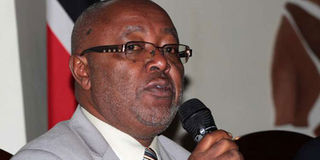Schools expected to submit details to placement service

John Muraguri, the chief executive officer of Kenya Universities and Colleges Central Placement Service, at Kenya School of Government in Nairobi on July 21, 2015. PHOTO | JAMES EKWAM | NATION MEDIA GROUP
What you need to know:
John Muraguri, the chief executive officer of the Kenya Universities and Colleges Central Placement Service, said the details will guide them to start the process of placing candidates in degree programmes that they have selected.
This week, Mr Muraguri disclosed that universities will present their capacities to enable the board to know the number of students who will be placed in their respective institutions.
The placement service is also expected to meet and decide on the number of candidates who will join universities and colleges starting in August.
Schools have until the end of Sunday to submit details of last year’s Kenya Certificate of Secondary Education (KCSE) examination candidates to the Kenya Universities and Colleges Central Placement Service (KUCCPS).
This is to enable admission in various degree programmes.
KUCCPS Chief Executive Officer John Muraguri said the details will guide them to start the process of placing candidates in degree programmes that they have selected.
This week, Mr Muraguri disclosed that universities will present their capacities to enable the board to know the number of students who will be placed in their respective institutions.
The placement service is also expected to meet and decide on the number of candidates who will join universities and colleges starting in August.
“We are working round the clock and hope that by the end of this week, we will know where to place students,” Mr Muraguri told the Nation.
Some 574,125 candidates sat the KCSE examination in 9,154 centres across the country.
Mr Muraguri said an announcement on revision of degree and diploma course choices by individual candidates will be made at an appropriate time through the media and the placement service website.
Some 88,929 candidates who attained the minimum university entry qualification of C+ and above are set to get direct entry to universities against a capacity of about 96,000.
PUBLIC UNIVERSITIES
Last year, 74,000 candidates joined public universities while 12,000 joined private universities under the government-sponsored programme, while another 12,000 joined colleges.
In colleges the declared capacity was 50,000 slots yet it is only 12,000 students who applied to join technical and vocational education and training colleges, leaving an excess capacity of 38,000 places.
A total of 44,792 candidates who scored C plain will now study for diploma courses at tertiary institutions, joining another 61,026 who scored C- and 80,951 D+ to scramble for about 50,000 available slots in 57 tertiary institutions and 70 public and private universities.
The government has ruled out lowering of the university entry grade to accommodate more students due to poor performance in last year’s examination.
In 2015, 91,378 of 165,766 students who scored the minimum university entry grade of C+ were locked out of university due to lack of space.
In 2016, Moi University admitted 5,825 students, followed by Kenyatta University at 5,598 and University of Nairobi at 5,374. Both public and private universities have the capacity to take in more than 160,000 students annually.
According to Education Cabinet Secretary Fred Matiang’i, the country must make the necessary adjustments.
“The time has come for us to embrace the role of tertiary and technical training in national development. We must shift from the populist view of white-collar jobs, which are highly pegged on university degree qualifications, and focus more on skills-oriented approaches,” said Dr Matiang’i.





